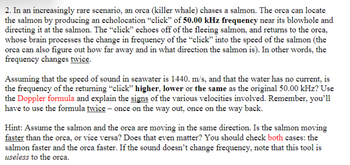Question

Transcribed Image Text:2. In an increasingly rare scenario, an orca (killer whale) chases a salmon. The orca can locate
the salmon by producing an echolocation "click" of 50.00 kHz frequency near its blowhole and
directing it at the salmon. The "click" echoes off of the fleeing salmon, and returns to the orca,
whose brain processes the change in frequency of the "click" into the speed of the salmon (the
orca can also figure out how far away and in what direction the salmon is). In other words, the
frequency changes twice.
Assuming that the speed of sound in seawater is 1440. m/s, and that the water has no current, is
the frequency of the returning "click" higher, lower or the same as the original 50.00 kHz? Use
the Doppler formula and explain the signs of the various velocities involved. Remember, you'll
have to use the formula twice - once on the way out, once on the way back.
Hint: Assume the salmon and the orca are moving in the same direction. Is the salmon moving
faster than the orca, or vice versa? Does that even matter? You should check both cases: the
salmon faster and the orca faster. If the sound doesn't change frequency, note that this tool is
useless to the orca.
Expert Solution
This question has been solved!
Explore an expertly crafted, step-by-step solution for a thorough understanding of key concepts.
This is a popular solution
Trending nowThis is a popular solution!
Step by stepSolved in 6 steps with 1 images

Knowledge Booster
Similar questions
- ultrasound physics For a breast examination, the sonographer replaces a 5 MHz transducer with a 10 MHz transducer. Which transducer frequency produces the stronger echo from a reflector at a depth of 5 cm? Assume that the transmitted intensity is the same for each frequency.arrow_forwardAt rest, a car’s horn sounds at a frequency of 550Hz. When the horn is sounded, while the car is moving down a street, a bicyclist moving at 8.50m/s in the direction opposite to the car hears a frequency of 575Hz. (a) What is the speed of the car? (b) If the cyclist slows down to 2.50m/s before passing the car, what is the new frequency detected by the cyclist? Assume that the car moves with the same speed, and that the speed of sound in air is 343m/s.arrow_forwardIt's Christmas time and you blast your Christmas music with the windows down in your car. Your grinchy roommate hears your music 30 meters away. The final note in the song is a B, playing at 493 Hz, but your roommate smiles because to him it sounds like a B-flat, playing at 440 Hz. How fast are you driving relative to your roommate? And in what direction?arrow_forward
- In echolocation, a RADAR used infrared to determine the distance of a far away object. Estimate this range if the sender has received the reflected signal after 5.0 µs. 1.5 km 15 km 60 km 6.0 kmarrow_forwardThe electrical power needed to operate a speaker in your audio system is 18.7 W. If this speaker has a circular opening with a radius of 0.0743 m and the average sound intensity at the opening is 22.1 W/m2, determine the ratio of sound output power Psound to electrical input power Pelectrical. Psound Pelectricalarrow_forwardTwo train whistles have identical frequencies of 1.58 102 Hz. When one train is at rest in the station and the other is moving nearby, a commuter standing on the station platform hears beats with a frequency of 4.00 beats/s when the whistles operate together. What are the two possible speeds that the moving train can have? moving away from the station ?m/s moving towards the station ?m/sarrow_forward
- Dolphins of the open ocean are classified as Type II Odontocetes (toothed whales). These animals use ultrasonic "clicks" with a frequency of about 55 kHz to navigate and find prey. Suppose a dolphin sends out a series of clicks that are reflected back from the bottom of the ocean 90 m below. How much time elapses before the dolphin hears the echoes of the clicks? (The speed of sound in seawater is approximately 1530 m/s.) What is the wavelength of 55 kHz sound in the ocean?arrow_forwardThank you!!!arrow_forwardQuestion 25 Read the passage about echolocation. Echolocation is used by some animals, such as whales and bats, to find the location of objects by sending out sound waves through a medium. The length of time it takes for the sound wave to strike an object and bounce back tells the location of the object. How would the length of time it takes a sound wave to return to a whale differ from the time it takes a sound wave to return to a bat? А A sound wave would return faster to a bat because sound travels faster in air than it does in water. A sound wave would return faster to a bat because the wavelength is shorter in air than in water. A sound wave would return faster to a whale because sound travels faster in water than it does in air. A sound wave would return faster to a whale because the wavelength is longer in water than in air. ©2021 Illuminate Education TM, Inc. hp B.arrow_forward
arrow_back_ios
arrow_forward_ios